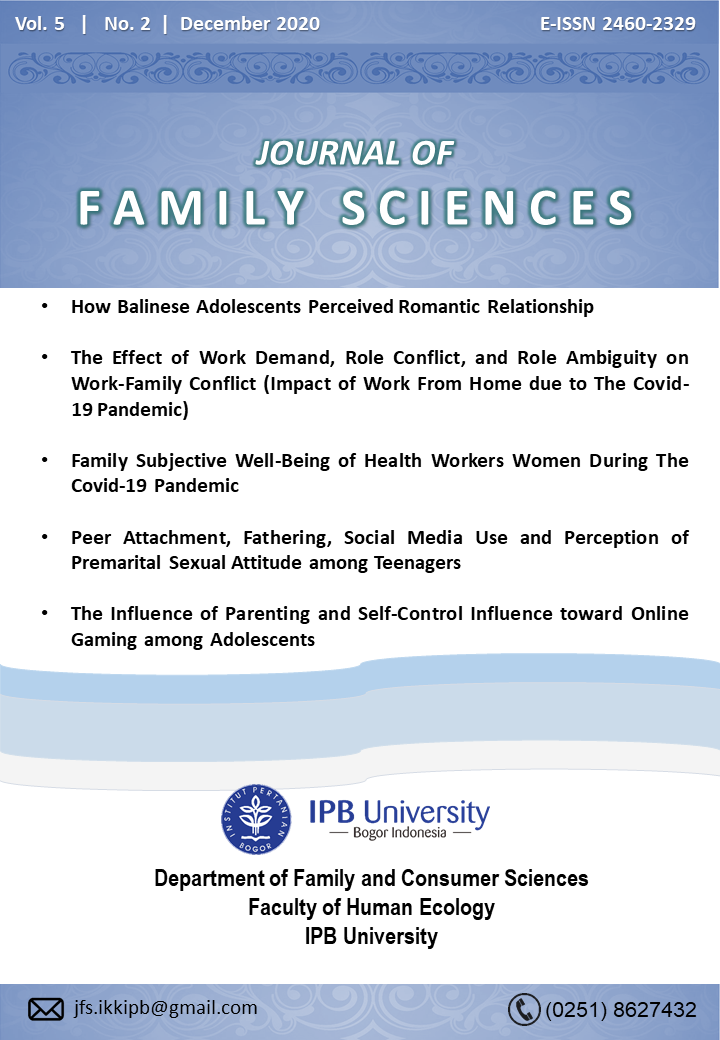How Balinese Adolescents Perceived Romantic Relationship
How Balinese Adolescents Perceived Romantic Relationship
Abstract
The romantic relationship is an interesting topic to study because it emerges as an important part of adolescent development that becomes increasingly important in subsequent years of individual development. One of the limitations of research in this field is the difficulty of providing unique and standards definitions of romantic relationships due to cultural differences in conceptions and the differences within individuals from the same cultural group. This study aims to explore the concept of a romantic relationship from the perceptions of Balinese adolescents and terms that represent it that can be used as a basis to comprehend the dynamics of romantic relationships in Balinese culture nowadays. Two phases of the study conducted through survey and FGD. Balinese adolescents were aged 15-17 years old (n= 277). Through thematic analysis procedures, some emergent themes were identified as romantic relationship conceptualization. This relationship was conceptualized as an exclusive relationship, consisting of affective, cognitive, and psychomotor dimensions, and was represented by many terms. This study concluded that the concept of romantic relationships for each individual from the same cultural group could be perceived differently, leading to varied forms of adolescents' behavior.
Downloads
References
Barton, A. W., Hurt, T. R., Futris, T. G., Sheats, K. F., McElroy, S. E., & Landor, A. M. (2017). Being committed: conceptualizations of romantic relationship commitment among low-income African Americans adolescents. Journal of Black Psychology, 43, 111-134.
Blackwood, E. (2000). Culture and women's sexualities. Journal of Social Issues, 56, 223-238. Doi: 10.1111/0022-4537.00162.
Blair, S.L. & Madigan, T.J. (2016). Dating attitudes and expectations among young Chinese adults: an examination of gender differences. The Journal of Chinese Sociology, 3(2), 1-19. Doi: 10.1186/s40711-016-0034-1.
Braun, V. & Clarke, V. (2006). Using thematic analysis in psychology. Qualitative Research in Psychology, 3(2), 77-101. Doi: 10.1191/1478088706qp063oa.
Boislard, M.A., van de Bongardt, D., & Blais, M. (2016). Sexuality (and lack there of) in adolescence and early adulthood: a review of the literature. Behavioral Sciences, 6(1), 1-24. Doi: 10.3390/bs6010008.
Brown, B. B., Feiring, C., & Furman, W. (1999). Missing the love boat: Why researchers have shied away from adolescent romance. In W. Furman, B. B. Brown, & C. Feiring (Eds.), The development of romantic relationships in adolescence (pp. 1-16). New York, NY: Cambridge University Press.
Cavanagh, S. E. (2007). The social construction of romantic relationships in adolescence: Examining the role of peer networks, gender, and race. Sociological Inquiry, 77(4), 572-600. Doi: 10.1111/j.1475-682X.2007.00207.x.
Collins, W. A. (2003). More than myth: the developmental significance of romantic relationships during adolescence. Journal of research on adolescence, 13(1), 1-24. Doi: 10.1111/1532-7795.1301001.
Collins, W.A., Furman, W., & Welsh, D.P. (2009). Adolescent Romantic Relationships. Article in Annual Review of Psychology, February 2009. Doi: 10.1146/annurev.psych.60.110707.163459.
Collins, W. A., & Madsen, S. D. (2006). Personal relationships in adolescence and early adulthood. In A. L. Vangelisti & D. Perlman (Eds.), The Cambridge handbook of personal relationships (pp. 191-209). New York, NY: Cambridge University Press.
Concept System, Inc. (2014). Teen dating Relationships: Udnerstanding and Comparing Youth and Adult Conceptualizations, Final Report. National Institute of Justice – Office of Justice Programs, U.S. Department of Justice.
Connoly, J. & McDonald, K.P. (2020). Cross-Cultural Perspectives on Dating and Marriage. In S. Hupp & J.D. Jewell (Eds.), The Encyclopedia of Child and Adolescent Development. John Willey & Sons, Inc.
Dharmayuda, I. M. S. (1995). Kebudayaan Bali: Pra-Hindu, Masa Hindu, dan Pasca Hindu. Denpasar: Kayumas Agung.
Davis, K. E., & Todd, M. J. (1982). Friendship and love relationships. In K. Davis (Ed.), Advances in descriptive psychology, Vol. 2 (pp. 79-122). Greenwich, CT: JAI Press.
Dhariwal, A., & Connolly, J. (2013). Romantic experiences of homeland and diaspora south asian youth: westernizing processes of media and friends. Journal of Research on Adolescence, 23(1), 45-56. Doi: https://doi.org/10.1111/j.1532-7795.2012.00803.x.
Eurazmi. (2018). Survei kisara ungkap perilaku seks remaja Denpasar usia 11-15 tahun sudah berhubungan intim. Retrieved: https://bali.tribunnews.com/2018/12/06/survei-kisara-ungkap-perilaku-seks-remaja-denpasar-usia-11-15-tahun-sudah-berhubungan-intim.
Furman, W., L., & Shaffer. (2003). The role of romantic relationships in adolescent development. In P. Florsheim (Ed.), Adolescent romantic relations and sexual behavior: Theory, research, and practical implications (pp.3–22). Mahwah, NJ: Lawrence Erlbaum Associates.
Furman, W., & Shoemaker, L.B. (2008). Patterns of interaction in adolescent romantic relationships: distinct features and links to other close relationships. Journal of Adolescence. 2008 December; 31(6), 771-788. Doi: 10.1016/j.adolescence.2007.10.007.
Furman, W., & Wehner. E.A. (1994). Romantic views: toward a theory of adolescent romantic relationships. in Personal Relationships during Adolescence, R. Montemayor, G. R. Adams, and T. P. Gullotta (Eds.). Thousand Oaks, CA: Sage.
Giordano P, Manning W, & Longmore M. (2005). The romantic relationships of African-American and white adolescents. Sociological Quarterly, 46(3), 545–568. Doi: 10.1111/j.1533-8525.2005.00026.x.
Hertlein, K. M. (2012). Digital dwelling: technology in couple and family relation- ships. Family Relations, 61(3), 374–387. Doi:10.1111/j.1741-3729.2012.00702.x.
Hochschild, A. R. (1979). Emotion work, feeling rules, and social structure. American Journal of Sociology, 85(3), 551–575. Doi: 10.1086/227049.
Hyman, M.R., & Sierra, J.J. (2016). Open-versus close-ended survey questions. Business Outlook, 14(2), 1-5.
Jackson, S.M. (1999). Issues in the dating violence research: a review of the literature. Aggression and Violent Behavior, 4(2), 233-247. Doi: 10.1016/S1359-1789(97)00049-9.
Kabir, S.M.S. (2016). Basic Guidelines for Research: An Introductory Approach for All Disciplines. Bangladesh: Book Zone Publication.
Karabanova, O.A. & Poskrebysheva, N.N. (2013). Adolescent autonomy in parent-child relations. Procedia – Social and Behavioral Sciences, 86, 621-628. Doi: https://doi.org/10.1016/j.sbspro.2013.08.624.
Karney, B.R., M.K. Beckett, R.L. Collins, R.N. & Shaw. (2007). Adolescent romantic relationships as precursors of healthy adult marriages. A review of theory, research and programs. RAND Labor and Population. Doi: 10.7249/TR488.
Kartika, A.A.D. & Budisetyani, I.G.A. (2018). Hubungan pola asuh demokratis dengan perilaku seksual pranikah pada remaja di Denpasar dan Badung. Jurnal Psikologi Udayana, 5(1), 63-71. ISSN: 2354 5607.
Kuperburg, A, & Padgett, J. E. (2015). Dating and hooking up in college: Meeting contexts, sex, and variation by gender, partner's gender, and class standing. Journal of Sex Research, 52(5), 517-531. Doi: 10.1080/00224499.2014.901284.
Lauren, J., Troy, A.B., & Carver, C.S. (2005). Two distinct emotional experiences in romantic relationships: effects of perceptions regarding approach of intimacy and avoidance of conflict. PSPB, 31(8), 1123-1133. Doi: 10.1177/0146167205274447.
Maguire, M., & Delahunt, B. (2017). Doing a thematic analysis: a practical, step-by-step guide for learning and teaching Scholars. AISHE-J 8(3), 3351-33514.
Manning, W. D., Longmore, M. A., & Giordano, P. C. (2000). The relationship context of contraceptive use at first intercourse. Family Planning Perspectives, 32(3), 104–110. DOI: 10.2307/2648158.
Panahi, S. (2015). Impact of Moderinzation on Development of Adolescents The Media, Culture, Technology. Unique Journal of Pharmaceutical and Biological Sciences, 3(2), 15-22.
Reja, U., Manfreda, K.L., Hlebec, V., & Vehovar, V. (2003). Open-ended vs. Close-ended Questions in Web Questionnaires. Development in Applied Statistics. Ferligoj, A., Mrvar, A. (Eds.). Ljubljana: FDV.
Royer, H.R., Keller, M.L., & Heidrich, S.M. (2009). Young adolescents' perceptions of romantic relationships and sexual activity. Sex Education, 9(4), 395-408. DOI: 10.1080/14681810903265329.
Sarantakos, S. (2005). Social research (3rd ed.). Basingstoke, UK: Palgrave Macmillan.
Seiffge-Krenke, I., Bosma, H., Chau, C., C ̧ ok, F., Gillespie, C., Loncaric, D., Molinar, R., Cunha, M., Veisson, M., & Rohail. I. (2010). All the need is love? Placing romantic stress in the context of other stressors: A 17-nation study. International Journal of Behavioral Development, 34(2), 106-112. Doi: https://doi.org/10.1177%2F0165025409360290.
Soller, B., Haynie, D.L., & Kuhlemier, A. (2016). Sexual intercourse, romantic relationship inauthenticity, and adolescent mental health. Social Science Research, 64, 237- 248. Doi:10.1016/j.ssresearch.2016.10.00.
Ting-Toomey, S., & Dorjee, T. (2019). Communicating across cultures. (2nd ed.). The Guildford Press.
Tskhay, K.O., & Rule, N.O. (2014). Sexual Orientation Across Culture and Time. Psychology of Gender and Culture. Safdar, S. & Kosakowska-Berzecka, N. (Eds.). Springer Publishing.
Vaterlaus, J.M., Tulane, S., Porter, B.D., & Beckert, T.E. (2018). The perceived influence of media and technology on adolescent romantic relationships. Journal of Adolescent Research, 33(6), 651-671. Doi: https://doi.org/10.1177/074355841771261.
van de Bongardt, D., Yu, R., Dekovic, M., & Meeus, W.H.J. (2015). Romantic relationships and sexuality in adolescence and young adulthood: The role of parents, peers, and partners. European Journal of Developmental Psychology, 12(5), 497-515. Doi: 10.1080/17405629.2015.1068689.
van Eeuwijk, P., & Zuzanna, A. (2017). How to ... Conduct a Focus Group Discussion (FGD). Methodological Manual. Basel: University of Basel.
Widhiyanti, D.A., Yuniarti, K.W., Minza, W.M., & Riyono, B. (2019). Schwartz's value Tyoes on Romantic Relationships: Exploratory Study on Balinese Society. Proceeding of the International Interdisciplinary Studies Seminar, IISS 2019. Doi: 10.4108/eai.23-10-2019.2293049.
Wijaya, I.M.K., Giri, M.K.W., Wahyuni, N.P.D., & Setiawan, K.H. (2018). Premarital Sex Behavior of Teenagers: A Case in Bali, Indonesia. International Journal of Health Sciences, 2(3), 11-21. Doi: 10.29332/ijhs.v2n3.211.
Whittecar, W.A. (2019). Late Adolescent Perceptions of Romantic Relationships and Romantic Experiences. Theses. Montana State University.
Authors who publish with this journal agree to the following terms:
- Authors retain copyright and grant the journal right of first publication with the work simultaneously licensed under

This work is licensed under a Creative Commons Attribution 4.0 International License. that allows others to share the work with an acknowledgement of the work's authorship and initial publication in this journal. - Authors are able to enter into separate, additional contractual arrangements for the non-exclusive distribution of the journal's published version of the work (e.g., post it to an institutional repository or publish it in a book), with an acknowledgement of its initial publication in this journal.
- Authors are permitted and encouraged to post their work online (e.g., in institutional repositories or on their website) prior to and during the submission process, as it can lead to productive exchanges, as well as earlier and greater citation of published work (See The Effect of Open Access).



_001.png)



